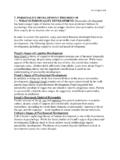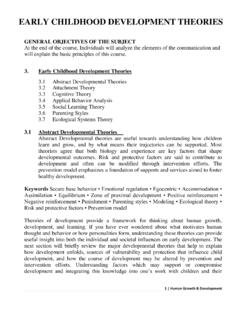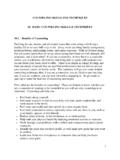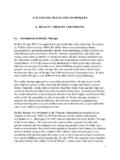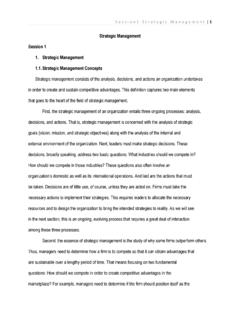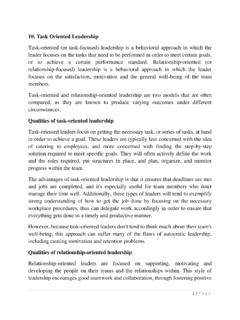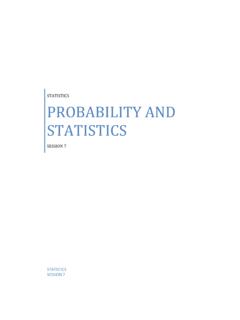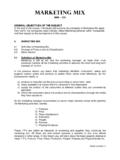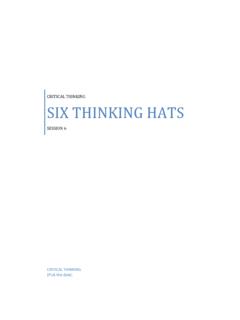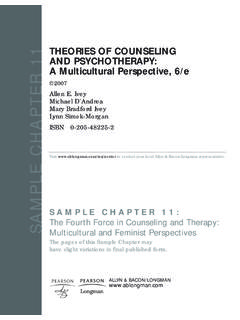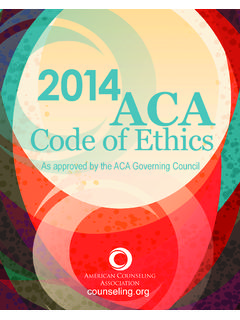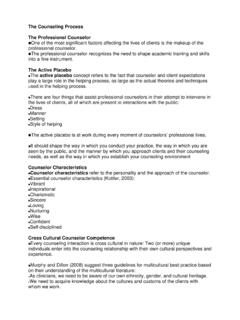Transcription of COUNSELING SKILLS AND TECHNIQUES 7. SCHOOL …
1 1 COUNSELING SKILLS AND TECHNIQUES 7. SCHOOL COUNSELING SKILLS & TECHNIQUES Background theories The professional SCHOOL counselor provides responsive services through the effective use of individual and small group COUNSELING , consulting, and referral SKILLS . There are three major theories that have shaped how counselors provide therapeutic interventions in schools. The first of these is based on the theoretical foundation provided by psychoanalysis, first defined and elaborated by Sigmund Freud. These approaches include those that can be described as neo-Freudian and those that contain elements first identified in Freud s writings. Eric H. Erikson, Alfred Adler, and Otto Rank have built models for practice based on these approaches and theories . The early behaviorists provided the second theory that guided approaches to therapeutic interventions. Behaviorism was first defined in psychological laboratories with carefully controlled experiments to look into how individuals learn and respond to their environments.
2 These approaches to therapy include William Glasser s reality therapy and choice theory. Related theories describe goal setting and brief solutions-focused COUNSELING , strengths based COUNSELING , cognitive therapy, behavioral COUNSELING , and cognitive behavioral TECHNIQUES . Each of these methods is based on helping clients learn new ways of thinking, processing information, and responding to their environments. The third major theoretical basis in COUNSELING is a uniquely American approach devised by Carl R. Rogers. His person or child centered approach is one that does away with the notion that a counselor is going to fix a problem the student is having. The approach is one that helps the student better understand his or her own thinking and find a resolution within. SCHOOL counselors have also adopted an abbreviated approach for providing student focused interventions that are time efficient and highly effective. Central to these solutions focused methods are strength-based SCHOOL COUNSELING and narrative therapies.
3 Ground Rules for SCHOOL Counselors When a new SCHOOL counselor begins a career, he or she must build a practice. Schools will have referral systems and children will be sent to see the counselor ; 2 however, an effective counselor soon develops a practice built on trust that has been earned. Students know the genuine thing when they see it, and a counselor who is trusted will have a reputation that is spread by word of mouth throughout the building and beyond into the community. This can happen only if the SCHOOL counselor has the personal warmth, integrity, and SKILLS to create a COUNSELING environment in which students know they will be listened to by a professional adult who is nonjudgmental and who truly understands them. The effective counselor knows COUNSELING theories and has the ability to employ TECHNIQUES that can help students. Beyond that knowledge and skill base, the counselor should be an optimist who has a true belief in his or her SKILLS and the ability of students to change and improve.
4 To be effective, the dynamic interactions of a group of students working with a counselor can employ a number of approaches to therapeutic intervention. Counselors need skill and an understanding of group dynamics and theory to provide an effective program of group COUNSELING . A new direction for SCHOOL counselors is in working within a virtual SCHOOL . The online world is changing old rules about the delivery of COUNSELING services for many students today. Counselors working in public schools must establish ground rules with students who begin the COUNSELING relationship. One is that everything discussed by the student and counselor is kept in confidence by both parties. Second is that there is a strict time limit to the length of each COUNSELING session. Counselors must establish boundaries, including the fact that they are paid professional employees of the SCHOOL who may never break the SCHOOL s rules or policies. The counselor works in the interest of each individual student; however, as a professional, the counselor maintains a separation from students who are receiving COUNSELING services.
5 Finally, counselors do not play favorites, make exceptions, or do anything to discourage any student or group of students from seeking assistance. Counselors must understand students and the culture of students as well as the culture of the SCHOOL . Effective counselors recognize their roles in the culture of the SCHOOL . The counselor also understands and respects the society created by students but never tries to become part of that culture. This implies the counselor is with it and up to date with popular culture but does not affect airs or try to act like the students. This will be immediately detected, and the counselor will be labeled by the students a phony and subsequently lose credibility. Central to the job is listening. This skill is one very few adults in a child s life have. The counselor must always be sensitive to all levels of communication being used by the student being counseled. Verbalizations make up one dimension; others include the student s posture and 3 body language, facial expressions, tone of voice, and gestures.
6 All aspects of the student-client being counseled must be mentally noted by the counselor and become part of the therapeutic dialogue. Listening in all these dimensions leads the SCHOOL counselor to be able to achieve empathy, the ability to sense and feel the feelings, understandings, motives, and attitude of the student being counseled as the counselor s own. The ability to understand why a student behaves in a particular way, what he or she is thinking, and what his or her motives and needs are is the essence of being a counselor. If the counselor is heard as judgmental by the student, this trusting relationship will never occur. Language by the counselor that starts with the pronoun you should be avoided. For example, never start a sentence with Don t you think .. , or You should/should not .. , or It s really your doing/fault that .. , and so on. Other characteristics of good, highly effective SCHOOL counselors can be found in self-reports.
7 One is self-deprecating humor. More than 30 years ago Norman Cousins published a report demonstrating the power of humor to improve the condition of medical patients. Counselors should make the COUNSELING office an enjoyable, never a threatening environment. A sincere smile and pleasant greeting should go to all students in and out of the counselor s office area. Group COUNSELING SCHOOL administrators often burden SCHOOL counselors with large caseloads and many expectations for expert assistance. The ability to employ group COUNSELING methods can greatly improve the efficiency of the counselor and make it possible to assist many more children. Each of the major theorists in COUNSELING has endorsed the use of groups, starting with Alfred Adler. The psychotherapy model of Adler assumed that there was a social need within us all that longed for acceptance and approval from others. Students with emotional problems have generally been unable to interact with others in successful ways.
8 Psycho-educational groups guided by the SCHOOL counselor can teach students social SKILLS and give them their first opportunities to be successful. Carl Rogers wrote positively about instituting what he described as encounter groups in schools and other educational institutions. Theorists believe that groups can give students accurate feedback about irrational thoughts and help them try different roles and approaches to problem solving. COUNSELING in the schools must match the developmental levels and needs of students. Before fifth grade, students have limited attention spans and are bound by a form of linear logic that emphasizes deductive reasoning and makes insight 4 impossible. Group COUNSELING with students at this developmental level should be focused on concrete issues that are easy to grasp and discuss. Primary level groups should be limited to four members or fewer. Eight is the maximum for middle and high SCHOOL students in a COUNSELING group that a counselor should lead.
9 There are three major psycho-educational group types that a SCHOOL counselor may make part of the SCHOOL s COUNSELING program. These are groups that encourage growth, improve SCHOOL climate, and reformative groups. Group Process The use of groups by the SCHOOL counselor is the most effective intervention available for most problems among adolescents. The key to a good psycho-educational group is a well-trained counselor who possesses sterling leadership SKILLS . Prior to the first group session, it is best if the counselor meets individually with each student who will participate. This meeting can help the counselor and student by identifying and clarifying the student s goals in becoming part of the group. The counselor can also review rules for the group: (1) all meetings are confidential, (2) no one ever gets laughed at or teased in or outside the group, (3) each member listens very carefully to what each other member is saying, and (4) meetings start and end on time.
10 After ground rules are set, the first session with a new group usually needs a group activity designed to be an icebreaker and way to allow group members to get to know and trust one another. These students will know of each other as kids in the same SCHOOL but will not know them the way members of a psycho-educational group eventually will. For each group session, the leader should have a plan of what he or she wishes to accomplish and provide exercises to facilitate reaching his or her goal. Counselors should be careful to notice and reinforce when the group is showing cohesion and support for one or more of its members. This is a good sign of the group s health. Leaders should note to themselves indications of the group developing norms. These are never expressed but always present in a working group. Group norms become evident when a student violates one, for example, when a student disses the group by putting ear buds in his or her ears and finds that others in the group are unhappy with his or her behavior.
